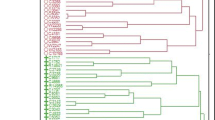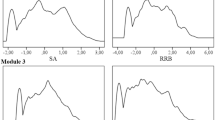Abstract
A cluster analytic study was conducted to empirically derive behaviorally homogeneous subtypes of pervasive developmental disorders (PDD). Subjects were clustered based on a broad range of behavioral symptoms which characterize autism. Behavioral variables were measured using several of the standardized psychometric instruments most commonly employed in assessing autistic individuals. The cluster solution indicated the presence of four distinct groups. Validity checks generally confirmed significant between-group differences on independent measures of social, language, and stereotyped behaviors. In addition, the four-group cluster solution was compared to previously developed typological systems of PDD (i.e., subcategories based on IQ, early onset, styles of social interaction, and DSM-III-R diagnosis). Results generally supported both the behavioral homogeneity of the four subgroups and also several important between-group differences. The potential utility of using cluster analyses to explore subtypes of PDD is discussed.
Similar content being viewed by others
References
Aldenderfer, M. S., & Blashfield, R. K. (1984).Cluster analysis. Beverly Hills: Sage.
Aman, M. G., & Kern, R. A. (1989). Review of fenfluramine in the treatment of developmental disabilities.Journal of the American Academy of Child and Adolescent Psychiatry, 28, 549–565.
American Psychiatric Association (1980).Diagnostic and statistical manual of mental disorders (3rd ed.). Washington, DC: Author.
American Psychiatric Association. (1987).Diagnostic and statistical manual of mental disorders (3rd ed., rev.). Washington, DC: Author.
August, G. J., Raz, N., & Baird, T. D. (1985). Brief report: Effects of fenfluramine on behavioral, cognitive, and affective disturbances in autistic children.Journal of Autism and Developmental Disorders, 15, 97–105.
August, G. J., Raz, N., & Baird, T. D. (1987). Fenfluramine response in high and low functioning autistic children.Journal of the American Academy of Child and Adolescent Psychiatry, 26, 342–346.
Beale, E. M. L. (1969).Cluster analysis. London: Scientific Control Systems.
Borgen, F. H., & Barnett, D. C. (1987). Applying cluster analysis in counseling psychology research.Journal of Counseling Psychology, 34, 456–468.
Comrey, A. L. (1985). A method for removing outliers to improve factor analytic results.Multivariate Behavioral Research, 20, 273–281.
Freeman, B. J., Ritvo, E. R., Yokota, A., & Ritvo, A. (1986). A scale for rating symptoms of patients with the syndrome of autism in real life settings.Journal of the American Academy of Child and Adolescent Psychiatry, 25, 130–136.
Garfin, D. G., McCallon, D., & Cox, R. (1988). Validity and reliability of the Childhood Autism Rating Scale with autistic adolescents.Journal of Autism and Developmental Disorders, 18, 367–378.
Grossman, H. J. (1983).Classification in mental retardation. Washington, DC: American Association on Mental Retardation.
Hertzig, M. E., Snow, M. E., New, E., & Shapiro, T. (1990). DSM-III and DSM-III-R diagnosis of autism and pervasive developmental disorder in nursery school children.Journal of the American Academy of Child and Adolescent Psychiatry, 29, 123–126.
Krug, D. A., Arick, J., & Almond, P. (1980). Behavior checklist for identifying severely handicapped individuals with high levels of autistic behavior.Journal of Child Psychology and Psychiatry, 21, 221–229.
Lambert, N., Windmiller, M., Thoringer, D., & Cole, L. J. (1975).AAMD Adaptive Behavior Scale (rev. ed.). Washington, DC: American Association on Mental Retardation.
Lorr, M. (1983).Cluster analysis for the social sciences. San Francisco: Jossey-Bass.
Matson, J. L. (1988).Treating childhood and adolescent psychopathology: A handbook. New York: Plenum Press.
Matson, J. L. (1989).Chronic schizophrenia and adult autism: Issues in diagnosis, assessment and treatment. New York: Springer.
Matson, J. L., & Mulick, J. A. (1991).Handbook of mental retardation (2nd ed.). New York: Pergamon.
Mesibov, G. B., Schopler, E., Schaffer, B., & Michal, N. (1989). Use of the Childhood Autism Rating Scale with autistic adolescents and adults.Journal of the American Academy of Child and Adolescent Psychiatry, 28, 538–541.
Milligan, G. W., & Cooper, M. C. (1985). An examination of procedures for determining the number of clusters in a data set.Psychometrika, 50, 159–179.
Perry, A., & Factor, D. C. (1989). Psychometric validity and clinical usefulness of the Vineland Adaptive Behavior Scales and the AAMD Adaptive Behavior Scale for an autistic sample.Journal of Autism and Developmental Disorders, 19, 41–55.
Pomeroy, J. C., Friedman, C., & Stephens, L. (1991). Autism and Asperger's: Same or different?Journal of the American Academy of Child and Adolescent Psychiatry, 29, 152.
Rescorla, L. (1988). Cluster analytic identification of autistic preschoolers.Journal of Autism and Developmental Disorders, 18, 475–492.
Ritvo, E. R., & Freeman, B. J. (1978). National Society for Autistic Children Definition of the Syndrome of Autism.Journal of Autism and Developmental Disorders, 8, 162–170.
Ritvo, E. R., Freeman, B. J., Geller, E., & Yuwiler, A. (1983). Effects of fenfluramine on 14 outpatients with the syndrome of autism.Journal of the American Academy of Child and Adolescent Psychiatry, 22, 549–558.
Ritvo, E. R., Freeman, B. J., Geller, E., Yokota, A., Schroth, P., & Novak, P. (1984). Study of fenfluramine in outpatients with the syndrome of autism.Journal of Pediatrics, 105, 823–828.
Rogers, S. J., & DiLalla, D. L. (1990). Age of symptom onset in young children with pervasive developmental disorders.Journal of the American Academy of Child and Adolescent Psychiatry, 29, 863–872.
Romesburg, H. C. (1984).Cluster analysis for researchers. Belmont, CA: Lifetime Learning.
Rutter, M. (1978). Diagnosis and definition of childhood autism.Journal of Autism and Developmental Disorders, 8, 139–161.
Rutter, M., & Garmezy, N. (1983). Developmental psychopathology. In E. M. Hetherington (Ed.),Handbook of child psychology (Vol. 4). New York: Wiley.
Rutter, M., & Schopler, E. (1992). Classification of pervasive developmental disorders: Some concepts and practical considerations.Journal of Autism and Developmental Disorders, 22, 459–482.
Sarle, W. S. (1983).The cubic clustering criterion. (Technical Report A-108.) Cary, NC: SAS Institute.
SAS Institute Inc. (1988).SAS/STAT User's Guide, Release 6.03 Edition. Cary, NC: Author.
Sattler, J. M. (1988).Assessment of children. San Diego: Author.
Schopler, E. (1978). On confusion in the diagnosis of autism.Journal of Autism and Developmental Disorders, 8, 137–138.
Schopler, E., Reichler, R. J., Devellis, R. F., & Daly, K. (1980). Toward objective classification of childhood autism: Childhood Autism Rating Scale (CARS).Journal of Autism and Developmental Disorders, 10, 91–103.
Schopler, E., Reichler, R. J., & Renner, B. R. (1988).The Childhood Autism Rating Scale. Los Angeles: Western Psychological Services.
Schreibman, L., & Mills, J. I. (1983). Infantile autism. In T. A. Ollendick & M. Hersen (Eds.),Handbook of child psychopathology. New York: Plenum Press.
Sevin, J. A., Matson, J. L., Coe, D. A., Fee, V. E., & Sevin, B. M. (1991). A comparison and evaluation of three commonly used autism scales.Journal of Autism and Developmental Disorders, 21, 417–432.
Siegel, B., Anders, T. F., Ciaranello, R. D., Bienenstock, B., & Kraemer, H. C. (1986). Empirically derived subclassification of the autistic syndrome.Journal of Autism and Developmental Disorders, 16, 275–293.
Siegel, B., Vukicevic, J., Elliot, G. R., & Kraemer, H. C. (1989). The use of signal detection theory to assess DSM-III-R criteria for autistic disorder.Journal of the American Academy of Child and Adolescent Psychiatry, 28, 542–548.
Sparrow, S. S., Balla, D. A., & Cicchetti, D. V. (1984). TheVineland Adaptive Behavior Scales. Minneapolis, MN: American Guidance Service.
Spitzer, R. L., & Siegel, B. (1990). The DSM-III-R field trial of pervasive developmental disorders.Journal of the American Academy of Child and Adolescent Psychiatry, 29, 855–862.
Szatmari, P. (1989).Literature review on the DSM-III-R criteria for autistic disorder. Report to the DSM-IV committee.
Szatmari, P., Tuff, L., Finlayson, A. J., & Bartolucci, G. (1990). Asperger's syndrome and autism: Neurocognitive aspects.Journal of the American Academy of Child and Adolescent Psychiatry, 29, 130–136.
Tager-Flusberg, H., Calkins, S., Nolin, T., Baumberger, T., Anderson, M., & Chadwick-Dias, A. (1990). A longitudinal study of language in autistic and Down syndrome children.Journal of Autism and Developmental Disorders, 20, 1–22.
Volkmar, F. (1987). Diagnostic issues in the pervasive developmental disorders.Journal of Child Psychology and Psychiatry, 28, 365–369.
Volkmar, F., Cicchetti, D. V., Dykens, E., Sparrow, S. S., Leckman, J. F., & Cohen, D. J. (1988). An evaluation of the Autism Behavior Checklist.Journal of Autism and Developmental Disorders, 18, 81–97.
Volkmar, F., Cohen, D. J., Bregman, J. D., Hooks, M. Y., & Stevenson, J. M. (1989). An examination of social typologies in autism.Journal of the American Academy of Child and Adolescent Psychiatry, 28, 82–86.
Volkmar, F., Sparrow, S. S., Goudreau, D., Cicchetti, D. V., Paul, R., & Cohen, D. J. (1987). Social deficits in autism: An operational approach using the Vineland Adaptive Behavior Scales.Journal of the American Academy of Child and Adolescent Psychiatry, 26, 156–161.
Ward, J. H. (1963). Hierarchical grouping to optimize an objective function.Journal of the American Statistical Association, 58, 236–244.
Wing, L., & Arwood, A. (1987). Syndromes of autism and atypical development. In D. J. Cohen & A. Donnelan (Eds.),Handbook of autism. New York: Wiley.
Wing, L., & Gould, J. (1979). Severe impairments of social interaction and associated abnormalities in children: Epidemiology and classification.Journal of Autism and Developmental Disorders, 9, 11–29.
Author information
Authors and Affiliations
Rights and permissions
About this article
Cite this article
Sevin, J.A., Matson, J.L., Coe, D. et al. Empirically derived subtypes of pervasive developmental disorders: A cluster analytic study. J Autism Dev Disord 25, 561–578 (1995). https://doi.org/10.1007/BF02178188
Issue Date:
DOI: https://doi.org/10.1007/BF02178188




